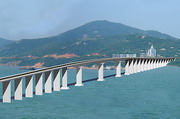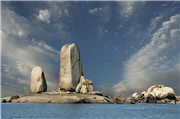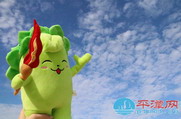Shoe brands show transition afoot
By Mike Bastin ( China Daily Europe )
Updated: 2016-08-05
|
|||||||||
Transformation from low-priced products to those with an emotional appeal to consumers indicates modernization of economy
Sadly it is still the case that macroeconomic indicators continue to dominate the international media when commenting on the state of China's economy. Recent figures on exports, imports and private investment continue to paint a fairly bleak picture.
But surely this is a necessary transition that all modernizing economics have to go through.

And surely by far the most important indicator with regard to China's economic transition is the level of international competitiveness of Chinese brands.
With this in mind, it is particularly pleasing to see the continued progress made by Chinese shoe brands.
Of course, Belle International Holdings Ltd needs little introduction here - it's still the No 1 women's shoe retailer in China, with 22 percent of the domestic market share. But Belle's recent international expansion is noteworthy. It has an ever-widening range of product sub-brands such as Belle, Staccato, Teenmix, Tata, Fato, JipiJapa, Joy & Peace and Bata.
While Belle is one among an increasing number of Chinese shoe brands that have now established themselves as serious rivals to the most well-known international brands, it is Chinese brand Anta and the Franco-Chinese brand Feiyue that have risen most prominently.
European readers are probably unaware of the Anta sports shoe brand and its rise. Also, they're likely unaware of the portfolio products sold under the Anta brand, which include apparel and accessories.
But recently, Anta achieved the unthinkable. The sports shoe brand, based in Southeast China's Fujian province, actually overtook global giant Nike as the market leader across China.
Sales of Anta sports shoes across China reportedly reached a staggering 40 million pairs for 2015, which represents a whopping 24.7 percent increase on the previous year.

Anta, positioned as an affordable brand, has most importantly broken through its product category and reinvented itself as a cool and fashionable sports shoe brand. This is excellent news for Chinese sports shoe brands and Chinese brands generally.
It is precisely this transition, from competitively priced product to emotional brand, that deserves most attention and recognition. It is this indicator, above all other economic indicators, that tells us most about the state of the Chinese economy and its progress on the path to modernization.
To focus on Anta's price differential with international rivals Adidas and Nike is to miss the point and misunderstand the real reason behind their overtaking of these global behemoths.
It is Anta's hybrid brand strategy, affordable price - not low price - and suitably emotional associations that lie behind the recent sales surge and market leadership. It was perhaps back in 2011 when Anta launched its "Basketball is my life" campaign that the brand building really took on a new lease of life. Since then, basketball associations in various guises have played a huge part in the transition from product to cool, fashionable brand.
Anta should now be seen as a role model for many other Chinese brands, and not just those from the sports shoe or even sports sectors.
Perhaps Anta learned most from other successful Chinese brands, many of which now enjoy very favorable international recognition such as Huawei and Lenovo.
But it may well have been shoe brand Feiyue that contributed considerably to brand building success at Anta.
In addition to a China-registered Feiyue, a completely unrelated French-registered namesake also can lay claim to a contribution.
Shoes made by Feiyue Shoes Holding of France command a premium price of between 500 yuan ($75; 67 euros) and 1,000 yuan. Brand building has now established this once "low-price only" brand as an essential part of the fashion identity for the most trendy younger consumers around the world.
Feiyue was first founded in 1963 in Shanghai and became a fashion icon in China in the 1980s. Shanghai Shenglong Shoes Co Ltd decided to revive it with a relaunch in 2003.
But in 2006, Frenchman Patrice Bastian registered the Feiyue brand name in his home country. Smart and, of course, emotionally suitable associations played a crucial part in Feiyue's global brand rise and sales of the French-registered company's shoes took off.
Back in 2008, on the set of the blockbuster film New York, I Love You, Hollywood heartthrob Orlando Bloom was seen sporting the Feiyue brand, creating a massive boost in image.
Additional, key linkups include a partnership between Feiyue Shoes and the French luxury fashion house Celine, which was the production of a limited edition, high-end brand.
Global reach was always the aim and also has been established via suitable collaborations. For example, joint marketing campaigns such as that with Singapore's famous nightclub Zouk have helped establish Feiyue as one of the most prestigious brands in its product category. Feiyue Shoes has kept a low profile in China - Shenglong reportedly threatened to sue if the French company entered the country.
Anta and others, now eyeing international markets from a position of domestic brand strength, should learn from the brand building strategy of Feiyue Shoes Holding. For example, prestige brand image can never be achieved unless prestige pricing is also pursued.
Such a brand image almost certainly needs similar collaborations with luxury fashion houses and global entertainment stars - obvious targets for Anta as well.
Domestic brand success should provide Anta and other successful Chinese shoe brands with the much-needed confidence to "go global". But, importantly, domestic brand building approaches and strategies should not necessarily be seen as the road to success in very different, international markets.
Once again, Feiyue could provide vital learning points here for Anta and China's other rapidly emerging shoe brands.
China-based Feiyue, not nearly as prestigious a brand as its French-based namesake, has also recently begun to focus on emotional brand association and to reposition its competitive price as "affordable" rather than "low".
But most noteworthy about the China-based Feiyue is the use of Chinese associations in order to build an emotionally positive brand image.
Anta and others please take note. In particular, Chinese art and artists present a perfect opportunity for effective collaborations where the association with Chinese shoe brands could lead to the latter establishing an extremely powerful and emotional image in the Chinese consumers' mind.
Not that this collaboration with Chinese art and artists should be employed for domestic markets only. International recognition, even admiration and respect, for Chinese art and artists is also a growing phenomenon and, therefore, also presents a pathway for global brand admiration and respect.
Finally, while Anta and others can learn much from Feiyue and other successful brand building stories in others sectors, it is also important not to lose sight of the reasons why Nike and Adidas are losing their once impregnable positions in the Chinese marketplace.
The relative decline of Nike and Adidas is due in part to the rise and rise of their Chinese competitors, but it is also the result of neglect. Nike and Adidas have failed to understand the Chinese consumer fully and the changing nature of Chinese consumerism, particularly among younger generations.
Instead, Nike and Adidas have largely stood still in China. Greater variety and more emotionally charged product sub-brand names comprise just one of the missing planks in their China strategies.
Anta and others should take note and already have brand building plans that stretch beyond total reliance on the corporate name. Product sub-brand names for different market segments will be needed and soon.
Overall, though, the Chinese shoe brand sector is one to watch, where strong branded products will emerge more and more and contribute significantly to the transition from low-cost product to high-quality brand across all sectors.
The author is a visiting professor at the University of International Business and Economics in Beijing and a senior lecturer at Southampton University. The views do not necessarily reflect those of China Daily.
( China Daily European Weekly 08/05/2016 page10)






